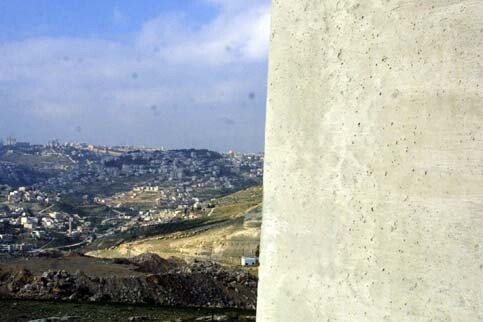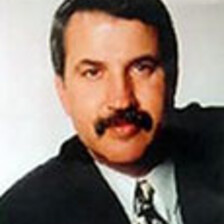The Electronic Intifada 4 February 2004

The Wall around Jerusalem. (Musa Al-Shaer)
Why do Americans understand so little about the Israeli-Palestinian conflict and the damage created by Israel’s colossal West Bank Wall?
The self-imposed US media blackout on the Wall’s construction finally began to lift last August when President Bush mentioned the problems created by Israel’s Wall “snaking its way through the West Bank.” Last December, a year and half after bulldozers began cutting the Wall’s path through Palestinian villages, Thomas Friedman hosted a Discovery Channel program in association with The New York Times, and Bob Simon anchored a CBS 60 Minutes segment introducing the controversy surrounding one of the world’s largest construction projects.
The Friedman/Discovery program was muddled, but Simon’s shorter yet stronger 60 Minutes segment presented a clear picture of the devastation resulting from the Wall’s construction. All of the US media’s failures in reporting on the Palestinian/Israeli conflict are played out to varying degrees within these two television productions. There are many reasons for the media blackout and failures, but the most important is probably fear that criticism of Israel, even reporting the truth about what Israel is doing, is quickly labeled anti-Semitic.
Both programs cover the difficulty that the Wall causes for the many Palestinians who have been cut off from their land and livelihoods. However, neither program mentions the possibility that Israeli military occupation and expulsion of Palestinians from their land might actually be the root causes of the conflict. On the contrary, one could leave both programs with the impression that Palestinian suicide bombings, which first occurred in 1994, are the cause of a conflict which began in the late 1800s. There is no mention that over 360 Palestinians were killed before the first suicide bombing of this uprising.
Indeed, the vast majority of what we hear and see in the US is about suicide bombing, and in both programs we see the depth of pain inflicted on Israelis by Palestinian suicide bombings through footage of their carnage, and disturbing, emotional scenes. Thomas Friedman actually visits the site of a suicide bombing immediately after it occurs. Although these are appalling scenes, they are certainly no less horrific or newsworthy than an Israeli apache helicopter firing missiles into crowds of civilians, or Israeli tanks killing and wounding Palestinian men, women and children. According to the Palestinian Red Crescent Society, more than 2,673 Palestinians have been killed in Israeli attacks and 24,541 have been wounded. Despite this, we see only examples of the 900 Israeli deaths in these two programs.
Thomas Friedman, the New York Times columnist, has an acute ability to convey a sense of objectivity, morality and pragmatism in his writing and on TV, while masking subtle prejudices against Palestinians and Arabs. Although Friedman does interview both prominent Israelis and Palestinians, his biases are revealed by his choice of interviewees, and his attitude towards them.
For official Israeli views, Friedman interviews Finance Minister Benjamin Netanyahu and the Mayor of Ariel Settlement Ron Nachman. He treats both as sympathetic, reasonable people, who are not to be challenged, even as they orchestrate policies that underlie the conflict and fuel violence. He nods respectfully as Netanyahu speaks, and then politely asks Netanyahu why the Wall is being built “through the Palestinians’ backyard.” Netanyahu ducks the question with a monologue on suicide bombing, avoiding the main objection of even Israel’s allies, the Wall’s location. Friedman never challenges Netanyahu, a man who regularly takes more extreme positions than Ariel Sharon.
In the interview with Ron Nachman, the Mayor and builder of the second largest West Bank settlement, Friedman and Nachman simply exchange friendly banter. Nachman jokes about not having horns or carrying a gun, contrary, he implies, to the image of settlers. Friedman doesn’t explain the reason for the image - constant settler violence against unarmed Palestinian civilians in the West Bank, or note that the settlers, already armed to the teeth, are protected by the Israeli army.
To his credit, Friedman regularly criticizes the settlements in his columns, resulting in some jibes from Nachman in the interview. In the Discovery program, however, Friedman describes the settlements as “Jewish communities”, as if they are just warm, cozy and harmless, all of which they could be, if they were not built on seized Palestinian land. He completely leaves out the fact that the settlements’ construction, defense and expansion have resulted in a continual use of force against Palestinians since 1967, and that all settlements in the Occupied Territories are illegal under international law.
Nor does Friedman place the settlements or the Wall in the context of the historical Zionist strategy of expelling Palestinians from their land, a strategy which began in the early 1900s, created 700,000 refugees in 1948, and continued with the construction of hundreds of illegal settlements. The justification of course is Biblical. After all, for Jewish and Christian Zionists, this is Judea and Samaria, not the West Bank
For official Palestinian views, Friedman interviews at length the mayor of the West Bank city of Qalqilya, Ma’arouf Zahran, perhaps to balance his interview with Nachman. He does not, however, interview a popular Palestinian leader in a position equivalent to Netanyahu, for example a Palestinian Legislative Council member.
Instead, Friedman interviews Canadian Palestinian legal adviser to the Palestinian Authority, Diane Buttu. When Buttu, a younger woman, responds to Friedman’s question about strategy on the Wall, Friedman is dismissive for the only time in the program. He tells Buttu that she is wasting her time and money, and that stopping Hamas will stop the Wall in a second. Buttu has no opportunity to respond to Friedman’s aggressive challenge, to perhaps mention that the Israeli occupation strengthens support for extremist groups like Hamas, or that occupation and settlement expansion never ceased, even during the Oslo Peace Process.
As in his New York Times columns, Friedman exhibits no difficulties telling Arabs what to do, nor are Arabs allowed to challenge his understandings. He appears clearly more comfortable with Israelis, who are given the space to disagree. Also the “expert analysts” are often Israelis, and rarely Palestinians. This subtle racism pervades most of Friedman’s writing on the Middle East.
Discovery does show with maps that the Wall is being built deep within the West Bank. Friedman also films the treatment of Palestinians at checkpoints. He even seeks out and asks young Palestinian men about humiliation, and they talk about their anger and the deaths of Palestinians. However, because Friedman has trouble listening to Palestinians, he is unable to represent their most significant experience, occupation, a word that Friedman amazingly utters only once in his hour long program — a word that to Palestinians means systematic violence and denial of fundamental rights touching every aspect of life since 1967, a word that means continued invasions, sieges, curfews and death.
Through a discussion with Mohammed Dahleh, the first Palestinian citizen of Israel to clerk for the Israeli Supreme Court, Friedman does reach an important conclusion: because Israel is building a Wall that will leave Israelis on both sides, rather than a Wall separating Israelis and Palestinians, Israel is creating a situation where Palestinians are likely to demand equal rights in a single binational state rather than demanding a Palestinian state of their own.
The much shorter Bob Simon 60 Minutes segment, contrasts positively with Friedman’s Discovery show. Despite similar weaknesses in representing the Palestinian experience, 60 Minutes much more clearly identifies the core issue of the Wall project. Simon notes that world leaders recognize Israel’s right to self-defense, but that this does not justify the Wall’s construction on Palestinian land. Because of its location, Simon suggests, the Wall may become more of an obstacle to peace than to terror. Unlike Friedman, Simon challenges statements by Israeli right-wingers, and interviews Israelis who criticize the Sharon government’s policies and the Wall.
The contrast with Friedman is most obvious when Simon interviews Israeli General Eival Gilady. While Friedman listened patiently to Gilady, Simon pointedly asks Gilady how he would feel if he couldn’t get from his house to his farm. When Gilady responds evasively, suggesting that all Palestinians are implicated in terrorism, Simon stops him, saying he doubts that the Palestinian farmers he met were involved in terrorism. Chastened, Gilady backs away from his attempt at spin.
Simon then interviews Israeli Minister Uzi Landau. Landau states defiantly that the Palestinians will not have all of Judea, Samaria and Gaza (The West Bank and Gaza Strip) because “Judea, Samaria and Gaza are part of our homeland.” Immediately afterwards, Simon points out that this Jewish homeland was 3,000 years ago, and that now 2 million Palestinians live in the West Bank. 60 Minutes lets Landau expose himself by presenting a hardline, religious view about land that is home to millions of Palestinians.
60 Minutes also interviews Ami Ayalon, who, as former Israeli Shin Bet Director, was responsible for security for the State of Israel. Ayalon recently joined three other former Shin Bet directors in criticizing the Sharon government’s security policies, saying that they simply create more violence. Ayalon asserts that giving Palestinians hope is more effective than building a Wall. In contrast, Friedman gave no indication that there are any Israeli Jews, let alone members of Israel’s security elite, who believe that the Wall will actually decrease security and not increase it.
Simon closes by noting that US government’s penalties for construction of the West Bank Wall will cost Israel only about $4 million out of Israel’s $2.6 billion in annual US aid. Thus 60 Minutes calls attention to the US government’s vital role in supporting expansionist Israeli policies, another important element that is absent from the Discovery show and the media at large.
Despite Thomas Friedman’s post-9/11 calls for moral clarity in his New York Times columns, he provides little moral clarity about a Wall that is effectively annexing large tracts of the West Bank to Israel and impoverishing hundreds of thousands of Palestinians. Just as Friedman used his position as a pundit with the New York Times to help sell the war in Iraq to Americans, and complains now about how the war he sold is being executed, he focuses his wrath on Palestinian suicide bombings while meekly questioning the implementation of Israel’s occupation and its expansionist policies.
Israeli “expert” Yaron Ezrahi wraps up Friedman’s Discovery show, saying that the Wall stands as a monument to failure. This is certainly true. The responsibility for this failure, however, falls as much on the shoulders of the American media as it does with the Israelis and the Palestinians. Pressure on the American government to stop supporting Israeli aggression must come from the American people. Information necessary for the American public to apply that pressure must come from the American media. Until we begin treating Palestinians as human beings and tell the story beyond the suicide bombings, the violence will continue, fueled by American money and arms for Israel.
In the meantime, groups like the International Solidarity Movement, International Women’s Peace Service, and Christian Peacemakers Team will continue to provide more complete news of what is happening on the ground, while supporting Palestinian non-violent resistance to the terror that is occupation.
Related Links
David Bloom is a co-editor of World War 3 Report (worldwar3report.com) and a member of New York City’s Jews Against the Occupation. Patrick Connors has managed humanitarian aid programs in the Middle East and Africa, and volunteered with the International Solidarity Movement in the West Bank supporting non-violent Palestinian protest against the Wall. Tom Wallace is the former Media Coordinator for the International Solidarity Movement, and the Executive Director of MidEast Focus, a communications awareness project.





